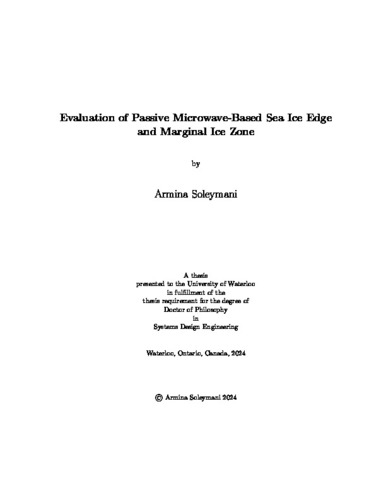| dc.description.abstract | Sea ice is a vital factor in polar navigation, numerical weather prediction models, and climate change studies. It significantly influences the global climate, northern communities, and Earth’s ecosystems. The sea ice edge and marginal ice zone are important areas for monitoring, as they affect ship navigation, human activities, and marine habitats. Passive microwave instruments offer valuable tools for monitoring the Earth’s surface, regardless of solar illumination. This advantage is particularly prominent in polar regions, where harsh climate conditions, restricted accessibility, and polar darkness pose challenges to data collection. This thesis is dedicated to the analysis of the sea ice edge and the marginal ice zone obtained from passive microwave algorithms, with the aim of enhancing our understanding of these influential regions. The first research compares the sea ice edge derived from three passive microwave algorithms against Canadian Ice Service charts over the Eastern Canadian Arctic. It also introduces a novel measurement for edge displacement error. The findings demonstrate differences in the performance of various algorithms across different seasons. During the freeze-up period, there is an increase in edge displacement error values, attributed to thin ice conditions. In April, the study observed the widest range of edge displacement error values, which were linked to fluctuations in wind speed and air temperature. The second study focuses on a 40-year trend analysis of the Arctic marginal ice zone using the Bootstrap sea ice product, employing two definitions: one based on sea ice concentration and the other based on sea ice concentration anomaly. Comparative analysis shows consistent trends in marginal ice zone fraction, with the anomaly-based definition exhibiting higher values during transitional periods. Furthermore, change point detection analysis highlights an increase in marginal ice zone fraction after 2005 for the concentration-based definition and after 2007 for the anomaly-based definition, suggesting the influence of climate change on sea ice concentration and mobility. In the third investigation, two sea ice products, passive microwave and synthetic aperture radar, are utilized to delineate the marginal ice zone in the Greenland Sea using two distinct definitions. The anomaly-based definition reveals a broader spatial marginal ice zone region, capturing the variability in sea ice concentration resulting from ice growth. This definition also maintains consistency across both sea ice products. Additionally, the study underscores the consistency of synthetic aperture radar in detecting the marginal ice zone (regardless of the definition) and its reduced sensitivity to the sea ice concentration anomaly standard deviation threshold, compared to passive microwave data. | en |

